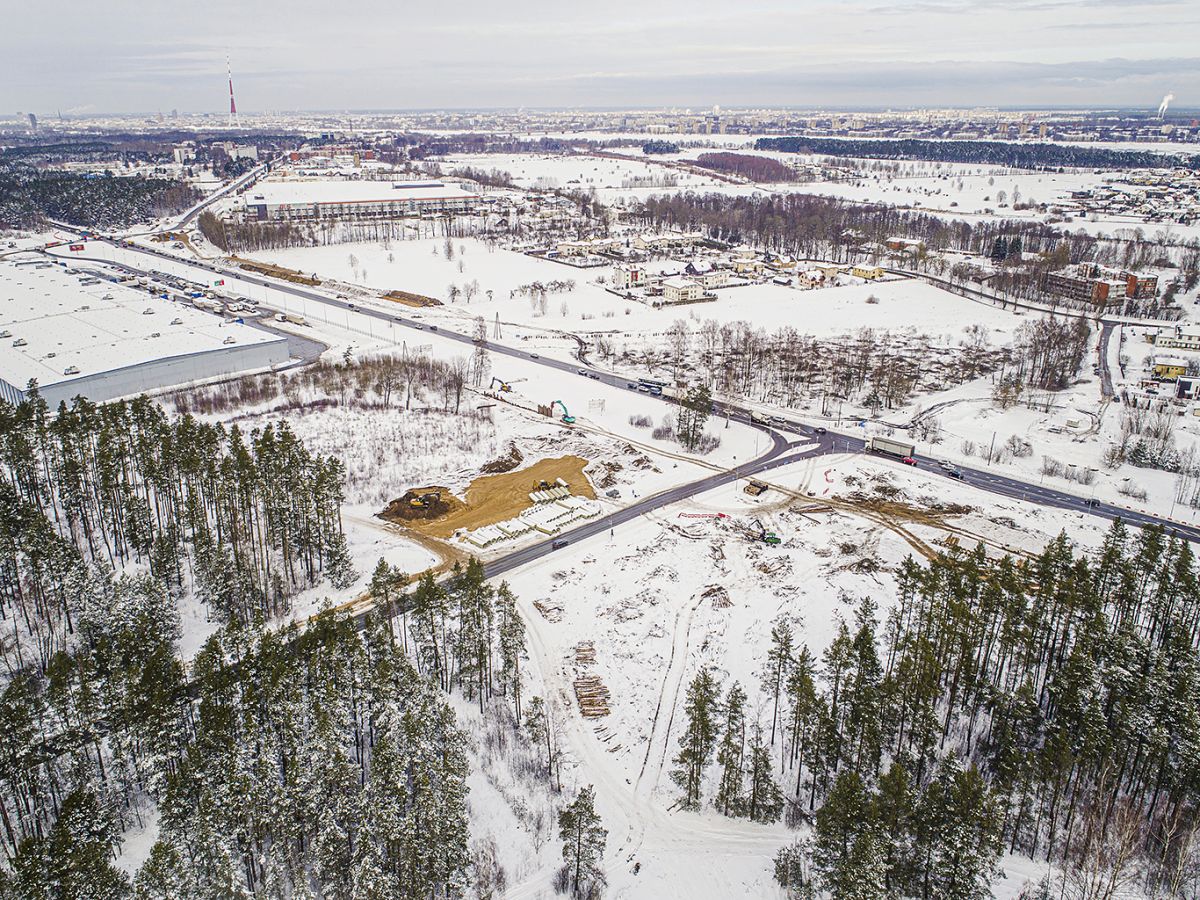As the construction works of the Ķekava bypass continue, the construction of parallel roads begins, including the section of Jaunās Ķekavas Street between the existing Tūjas Street and the promising Everesta Street, the representatives of VSIA “Latvijas valsts ceļi” (LVC) informed LETA.
The main route of the bypass will provide transit and intercity traffic, while this street will serve as a connection between the municipal road infrastructure and the multi-level intersections of the bypass, so that local residents can get to Ķekava and Riga, on the other side of the Ķekava bypass. Without such a connection, the access of local residents to the high-speed Ķekava bypass, as well as to the current Bauska highway, would be very difficult or even impossible.
In order to build this street, it is also necessary to cut down the bushes and trees marked in the construction project. Another location on the street is not possible due to the main engineering communications (water mains, gas pipeline, high voltage line). The construction project has been approved in accordance with legislation and regulatory enactments, it has been approved by Ķekava Municipality, the State Environmental Service, VSIA “Autotransporta direkcija”, engineering network holders and others.
An Impact and Environmental Assessment (EIA) procedure was also carried out for the construction of the Kekava bypass main route and parallel roads, which has received approval from all involved institutions, including the State Environmental Monitoring Bureau. During the elaboration of the EIA, a public consultation also took place, as far as possible, the proposals expressed by the population were evaluated and taken into account, according to the representatives of LVC. The status of an object of national interest has been determined for the Kekava bypass.
Representatives of LVC explain that when building new infrastructure objects, it is often not possible to realize all the wishes of the residents, as well as to keep the surroundings intact, this also applies to the bypass and related infrastructure. Some residents of Everesta Street have expressed dissatisfaction with the construction works and related works. After the completion of the construction works, the customer LVC and the private partner “Kekava ABT” will evaluate whether it is possible to restore the bush plantations between the route and the residential area, and if so, will carry out landscaping.
Representative of JSC “Ceļuprojekts”, designer Ilmārs Gorda explains that the main carriageway of Ķekava bypass will be expanded to four lanes, building the main highway and observing all traffic safety requirements. These requirements include the elimination of all level crossings. In its turn, Jaunā Ķekavas Street will provide local residents with access to the Bauska Highway (A7) in Baložu Street in Baloži, as well as at the Kekava Bypass and the existing Bauska Highway (A7) traffic junction. The new Ķekavas Street will create the necessary connection between the town of Baloži and the village of Lapenieki and will reduce the driving distances that will have to be traveled by locals to reach destinations in the immediate vicinity.
Although no traffic restrictions have been introduced at the construction site at the moment, drivers may have to reckon with certain inconveniences in the spring and plan additional travel time when leaving Riga or entering Riga on the Bauska highway, LVC representatives inform. In order to reduce inconveniences, local bypass roads will be built near Valdlauči and Baloži, along which traffic will be organized. Drivers should also be aware that the organization of traffic may change frequently during construction.
Residents should take into account that after the construction of the Ķekava bypass, there will be a break in the Ķekava-Plakanciems (V6) motorway – a crossing over the bypass will not be possible, but turning points will be created on both sides, LVC representatives inform. The V6 motorway will remain and will continue to provide access to the properties on both sides of the ring road, using vehicles and using the existing road network from Jaunciems and the Riga ring road (A5 Salaspils-Babite), but a longer route will have to be taken into account.
Currently, the crossing of the V6 motorway and the Ķekava bypass is not planned, LVC representatives point out. This decision was made because solutions are currently being developed for the Rail Baltica high-speed railway line, which will be located near the ring road and the V6 highway, so it is not yet known how far and with what technical parameters the new railway will be located.
Therefore, even now it is not possible to predict what solutions would be needed for the crossing of the local highway and both high-speed transport highways, LVC representatives explain. In the future, access solutions in this area will be assessed in the context of Rail Baltica solutions, as well as the planned reconstruction of the Riga bypass (A5 Salaspils-Babīte) into a high-speed motorway.
Implementing the Ķekava bypass project, almost 100 kilometers of strip will be built and 220,000 tons of asphalt will be laid. 450,000 tons of dolomite and granite rubble, as well as 520,000 cubic meters of sand will also be used in the construction of the track.
For the first time in Latvia, thin-layer asphalt technology will be used for the wear layer of the Kekava bypass, as well as prefabricated concrete culverts designed and manufactured in the Czech Republic with particularly pronounced durability and resistance to aggressive climatic conditions will be used in construction.
The total length of metal barriers along the entire length of the route will reach 40,000 meters, but the concrete barrier – 4,000 meters. 14 artificial buildings and noise solutions will also be built. Also, during the project, the main water pipeline, gas pipelines and three high-voltage line crossings will be rebuilt, as well as rainwater sewerage networks will be built. Approximately 900 lighting fixtures will be installed.
In order to monitor the newly built road 24 hours a day after the completion of construction works (surface quality, driving conditions, etc.), a traffic control center will be set up, consisting of 20 video surveillance cameras, two meteorological stations, ten traffic flow sensors and a traffic flow data analysis system. .
During the busiest phase of the construction works, up to 450 people will work on the construction site, as well as more than 100 road transport units and 50 machinery units.
It has already been reported that in July 2021, an agreement was signed on the construction of the Kekava bypass, which is the first large-scale public-private partnership project in road construction in the Baltic States, which will be implemented according to the “design-build-finance-maintain” model.
Of the two bidders that submitted, “Kekava ABT” was selected as the most economically advantageous bid, which also had the lowest price. TIIC 2 (SCA) SICAR, an investment fund incorporated in Luxembourg and controlled by TIIC, controls the association of these persons with 80% of the total investment. TIIC is an independent infrastructure company with offices in Luxembourg, Portugal and France, specializing in large-scale transport and public infrastructure projects in Europe and around the world.
In order to ensure the implementation of the Ķekava bypass project, including its design, construction, financing and maintenance, the Ministry of Transport was authorized to assume long-term state budget liabilities not exceeding 265.729 million euros for the period from 2021 to 2043, and the state long-term budget commitments of EUR 38.205 million for value added tax (VAT) payments.
The construction works are planned to be completed by the end of 2023, while the road will be maintained by the private partner for another 20 years after the completion of the construction works, thus the completion of the entire public-private partnership project is planned for 2043.
–
It is strictly forbidden to use, copy or reproduce the materials published on iAuto.lv on other Internet portals, mass media or otherwise handle the materials published on iAuto.lv without the written permission of EON SIA.


